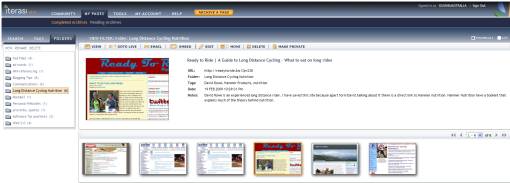Organising Search Information
As we saw in the previous post the web contains millions of pieces of information.Of course not all of this information is relevant to our needs. As we search each of the articles, there comes a time when we need to file the retrieved information away for further reference. We could do this the easy (and ecologically unfriendly) way of printing out the information we require. In computer speak we would create a hard copy. This of course has many benefits. We can write notes in the page margins, we can take the paper with us and read it later at our leisure and eventually file it away until we have the inevitable clean out at the end of the study period, and the paper ends up in the recycling bin.
Alternatively, we can bookmark the information. A bookmark is defined as :A stored location for quick retrieval at a later date. Web browsers provide bookmarks that contain the addresses (URLs) of favourite sites. Most electronic references, large text databases and help systems provide bookmarks that mark a location users want to revisit in the future. (PC Mag.com).
I readily admit that I am a big user of paper as I print out the articles that I require for assignments and various other reading. I like the feel of turning the page and highlighting relevant bits that I want to quote or write about. I find it awkward to read articles on-line. I find it difficult to flick backwards and forwards as I come to grips with the information contained in the article. This is especially true if the article is particularly long.
But I need to change. Before this course I had used the Bookmarks tab in my Firefox browser. I had no system, despite having a system to file documents in appropriate folders and directories. I did not apply the same discipline to bookmarks. I also regularly deleted them as , I could not remember why I had saved them in the first place, or I had finished with them. The list would get quite long.
During this study period, thanks to fellow students and some research in to bookmark managers I discovered several great tools to help me become better organised. I examined several social bookmarking sites as listed in About.com. I also came across Iterasi. The benefit of this product, in my opinion, is that it saves the web page as it appears at the time of capture. There are many times when the URL of a particular page changes (for what ever reason) so that when you return to a bookmarked favourite, it is no longer there. This does not happen with Iterasi. The page is captured as is, and will always display as it was. This is especially beneficial when capturing a newspaper website. The page constantly changes. I can bookmark the page at 10am and when I click on the bookmark at midday, the page has change, With Iterasi, I get the page as it was at 10am. I thought it was cool.

The screenshot above shows an example of how Iterasi displays its information. For each site it shows a screenshot. It also then displays the URL and the title of the article. I am aslo able to explore what other Iterasi users have bookmarked.
This topic certainly has been an eye opener for me. I can now better organise my bookmarks. I can also look at other bookmarking sites such as delicious to see what other users have bookmarked in topics I am interested in.
Yesterday Simon Mainwaring (a fellow Student in Net11) alerted us to another social bookmarking product Diigo. I have not had a chance to fully explore this as yet, but it takes bookmarking to a new level by allowing highlighting and the insertion of comments.
I was but a lad just starting work when there was talk of paperless offices. 30 years later we do not appear to be any closer. Maybe this type of bookmarking and the cloud will be the start.
 Subscribe to RSS Feed
Subscribe to RSS Feed